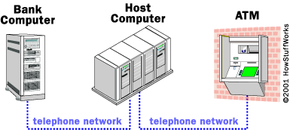How Do ATMs Work?
An ATM is simply a data terminal with two input and four output devices. Like any other data terminal, the ATM has to connect to, and communicate through, a host processor. The host processor is analogous to an Internet service provider (ISP) in that it is the gateway through which all the various ATM networks become available to the cardholder (the person wanting the cash).
Most host processors can support either leased-line or dial-up machines. Leased-line machines connect directly to the host processor through a four-wire, point-to-point, dedicated telephone line. Dial-up ATMs connect to the host processor through a normal phone line using a modem and a toll-free number, or through an Internet service provider using a local access number dialed by modem.
Advertisement
Leased-line ATMs are preferred for very high-volume locations because of their thru-put capability, and dial-up ATMs are preferred for retail merchant locations where cost is a greater factor than thru-put. The initial cost for a dial-up machine is less than half that for a leased-line machine. The monthly operating costs for dial-up are only a fraction of the costs for leased-line.
The host processor may be owned by a bank or financial institution, or it may be owned by an independent service provider. Bank-owned processors normally support only bank-owned machines, whereas the independent processors support merchant-owned machines.
